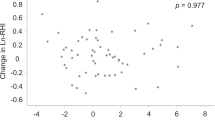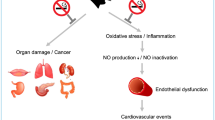Abstract
Calcium antagonists are reported to have protective effects on the endothelium in vitro and in vivo. Especially, nifedipine, among many calcium antagonists, was shown to improve endothelial dysfunction in patients with hypertension. However, no report has determined whether the improvement of endothelial dysfunction by nifedipine is due to direct effects or indirect effects such as its hypotensive effect. Thus, in this study, we evaluated the direct effects of nifedipine on smoking-induced endothelial dysfunction, since cigarette smoking itself is a major factor in damage of endothelial cells, as well as hypertension. We examined whether nifedipine improves endothelial function in 10 normotensive smokers without any risk factors for atherosclerosis. The subjects were treated with 20 mg nifedipine monotherapy (n=10) or placebo (n=10) for 4 weeks. Nifedipine did not affect blood pressure and heart rate of normotensive smokers. We measured forearm blood flow (FBF) by strain-gauge plethysmography after 2 and 4 weeks of treatment. Changes in vasodilator response to reactive hyperaemia were significantly improved in nifedipine-treated subjects (P<0.05), while there was no significant change in FBP response in control subjects. Response to nitroglycerin was not changed in either group. Moreover, to evaluate the mechanisms of the direct effects of nifedipine on the endothelium, we focused on hepatocyte growth factor (HGF), which is a novel angiogenic growth factor with an antiapoptotic action on endothelial cells. Interestingly, serum HGF concentration in smokers treated with nifedipine was significantly elevated both at 2 and 4 weeks (P<0.05). Overall, these results demonstrated direct effects of nifedipine in the improvement of endothelial dysfunction in normotensive smokers. The increase in serum HGF concentration by nifedipine might contribute to the improvement of endothelial dysfunction.
This is a preview of subscription content, access via your institution
Access options
Subscribe to this journal
Receive 12 digital issues and online access to articles
$119.00 per year
only $9.92 per issue
Buy this article
- Purchase on Springer Link
- Instant access to full article PDF
Prices may be subject to local taxes which are calculated during checkout


Similar content being viewed by others
References
Kato J et al. Risk factors and predictors of coronary arterial lesions in Japanese hypertensive patients. Hypertens Res 2001; 24: 3–11.
Glantz SA, Parmley WW . Passive smoking and heart disease. Epidemiology, physiology, and biochemistry. Circulation 1991; 83: 1–12.
Zembowicz A, Hatchett RJ, Radziszewski W, Gryglewski RJ . Inhibition of endothelial nitric oxide synthase by ebselen. Prevention by thiols suggests the inactivation by ebselen of a critical thiol essential for the catalytic activity of nitric oxide synthase. J Pharmacol Exp Ther 1993; 267: 1112–1118.
Benowitz NL . The role of nicotine in smoking-related cardiovascular disease. Prev Med 1997; 26: 412–417.
Czernin J et al. Effect of acute and long-term smoking on myocardial blood flow and flow reserve. Circulation 1995; 91: 2891–2897.
Celermajer DS et al. Cigarette smoking is associated with dose-related and potentially reversible impairment of endothelium-dependent dilation in healthy young adults. Circulation 1993; 88: 2149–2155.
Barry J et al. Effect of smoking on the activity of ischemic heart disease. JAMA 1989; 261: 398–402.
Raij L, DeMaster EG, Jaimes EA . Cigarette smoke-induced endothelium dysfunction: role of superoxide anion. J Hypertens 2001; 19: 891–897.
Snajdar RM, Busuttil SJ, Averbook A, Graham DJ . Inhibition of endothelial cell migration by cigarette smoke condensate. J Surg Res 2001; 96: 10–16.
Mak IT, Boehme P, Weglicki WB . Antioxidant effects of calcium channel blockers against free radical injury in endothelial cells. Correlation of protection with preservation of glutathione levels. Circ Res 1992; 70: 1099–1103.
Betz E, Hammerle H, Strohschneider T . Inhibition of smooth muscle cell proliferation and endothelial permeability with flunarizine in vitro and in experimental atheroma. Res Exp Med (Berl) 1985; 185: 325–340.
Gunther J et al. Nitric oxide (EDRF) enhances the vasorelaxing effect of nitrendipine in various isolated arteries. Basic Res Cardiol 1992; 87: 452–460.
Lichtlen PR et al. Retardation of angiographic progression of coronary artery disease by nifedipine. Results of the International Nifedipine Trial on Antiatherosclerotic Therapy (INTACT). INTACT Group Investigators. Lancet 1990; 335: 1109–1113.
Loaldi A et al. Comparison of nifedipine, propranolol and isosorbide dinitrate on angiographic progression and regression of coronary arterial narrowings in angina pectoris. Am J Cardiol 1989; 64: 433–439.
Hayashi S et al. Autocrine–paracrine effects of overexpression of hepatocyte growth factor gene on growth of endothelial cells. Biochem Biophys Res Commun 1996; 220: 539–545.
Nakamura Y et al. Hepatocyte growth factor is a novel member of the endothelium-specific growth factors: additive stimulatory effect of hepatocyte growth factor with basic fibroblast growth factor but not with vascular endothelial growth factor. J Hypertens 1996; 14: 1067–1072.
Iwatsubo H et al. Converting enzyme inhibitor improves forearm reactive hyperaemia in essential hypertension. Hypertension 1997; 29: 286–290.
Yamada A et al. Rapid and sensitive enzyme-linked immunosorbent assay for measurement of HGF in rat and human tissues. Biomed Res 1995; 16: 105–114.
Nakamura T . Structure and function of hepatocyte growth factor. Prog Growth Factor Res 1991; 3: 67–86.
Boros P, Miller CM . Hepatocyte growth factor: a multifunctional cytokine. Lancet 1995; 345: 293–295.
Tare M et al. Hyperpolarization and relaxation of atrial smooth muscle caused by nitric oxide derived from the endothelium. Nature 1990; 346: 69–71.
Suga S et al. Endothelial production of C-type natriuretic peptide and its marked augmentation by transforming growth factor-β. Possible existence of ‘A vascular natriuretic peptide system’. J Clin Invest 1992; 90: 1145–1149.
Dzau VJ . The role of mechanical and humoral factors in growth regulation of vascular smooth muscle cells and cardiac myocytes. Curr Opin Nephrol Hypertens 1993; 2: 27–32.
Nakamura Y et al. Expression of local hepatocyte growth factor system in vascular tissues. Biochem Biophys Res Commun 1995; 215: 483–488.
Nakano N et al. Increased serum hepatocyte growth factor (HGF) and 13 decreased local HGF in spontaneously hypertensive rats. (abstract) J Hypertens 1996; 14: S67.
Hayashi K et al. In vivo transfer of human hepatocyte growth factor gene accelerates re-endothelialization and inhibits neointimal formation after balloon injury in rat model. Gene Therapy 2000; 7: 1664–1671.
Aoki M et al. Inhibition of neointimal formation after balloon injury by Cilostazol, accompanied by improvement of endothelial dysfunction and induction of hepatocyte growth factor in rat diabetes model. Diabetologia 2001; 44: 1034–1042.
Hayashi S et al. Potential role of hepatocyte growth factor, a novel angiogenic growth factor, in peripheral arterial disease: downregulation of HGF in response to hypoxia in vascular cells. Circulation 1999; 100(Suppl II): II–301-II-308.
Morishita R et al. Potential role of endothelium-specific growth factor, hepatocyte growth factor, on endothelial damage in diabetes mellitus. Diabetes 1997; 46: 138–142.
Acknowledgements
We wish to thank Aiko Yamada and Naoko Saitoh for their excellent technical assistance. This work was partially supported by grants from the Japan Health Sciences Foundation, a Grant-in-Aid from The Ministry of Public Health and Welfare, a Grant-in-Aid for the Development of Innovative Technology, a Grant-in-Aid from Japan Promotion of Science, and Special Coordination Funds of the Ministry of Education, Culture, Sports, Science and Technology of the Japanese Government.
Author information
Authors and Affiliations
Corresponding author
Rights and permissions
About this article
Cite this article
Yamasaki, K., Aoki, M., Makino, H. et al. Effect of nifedipine on endothelial function in normotensive smokers: potential contribution of increase in circulating hepatocyte growth factor. J Hum Hypertens 18, 701–705 (2004). https://doi.org/10.1038/sj.jhh.1001727
Received:
Revised:
Accepted:
Published:
Issue Date:
DOI: https://doi.org/10.1038/sj.jhh.1001727
Keywords
This article is cited by
-
Comparison of the effects on maternal endothelial cell activation: an in vitro study of anti-hypertensive drugs clinically used in pre-eclampsia
Journal of Human Hypertension (2022)



